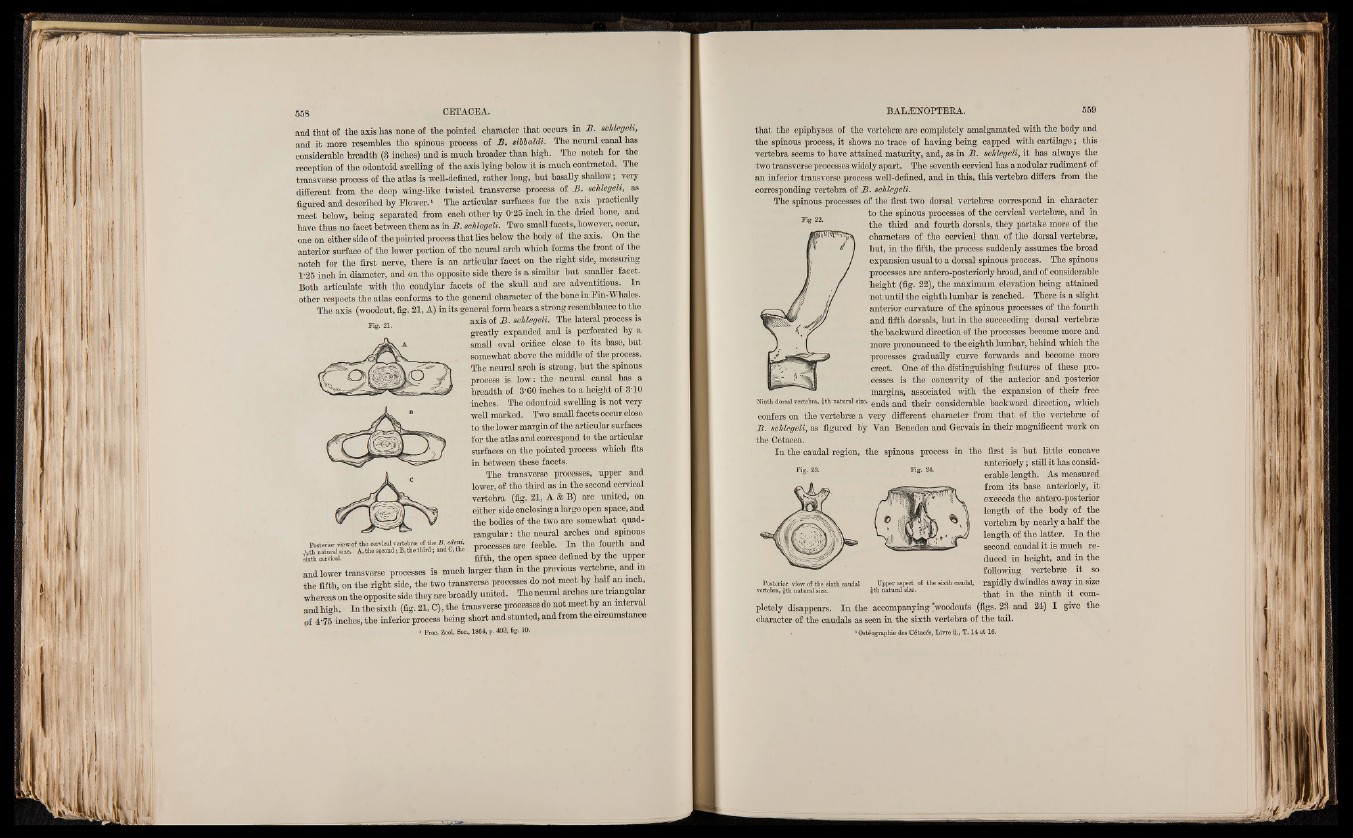
that of the axis has none of the pointed character that occurs in B. schlegeli,
and it more resembles the spinous process of B. sibbaldi. The neural canal has
considerable breadth (3 inches) and is much broader than high. The notch for the
reception of the odontoid swelling of the axis lying below it is much contracted. The
transverse process of the atlas is well-defined, rather long, but basally shallow; very
different from the deep wing-like twisted transverse process of B. schlegeli, as
figured and described by Elower.1 The articular surfaces for the axis practically
meet below, being separated from each other by 0*25 inch in the dried bone, and
have thus no facet between them as in B. schlegeli. Two small facets, however, occur,
one on either side of the pointed process that lies below the body of the axis. On the
anterior surface of the lower portion of the neural arch which forms the front of the
notch for the first nerve, there is an articular facet on the right side, measuring
1*25 inch in diameter, and on the opposite side there is a similar but smaller facet.
Both articulate with the condylar facets of the skull and are adventitious. In
other respects the atlas conforms to the general character of the bone in Ein- Whales.
The axis (woodcut, fig. 21, A) in its general form bears a strong resemblance to the
axis of B. schlegeli. The lateral process is
greatly expanded and is perforated by a
small oval orifice close to its base, but
somewhat above the middle of the process.
The neural arch is strong, but the spinous
process is low • the neural canal has a
breadth of 3’60 inches to a height of 3T0
inches. The odontoid swelling is not very
well marked. Two small facets occur close
to the lower margin of the articular surfaces
for the atlas and correspond to the articular
surfaces on the pointed process which fits
in between these facets.
The transverse processes, upper and
lower, of the third as in the second cervical
vertebra (fig. 21, A & B) are united, on
either side enclosing a large open space, and
the bodies of the two are somewhat quadrangular
: the neural arches and spinous
processes are feeble. In the fourth and
Posterior view of the cervical vertebra of the B . edeiri,
-Vth natural size. A, the second; B, the third; and C. the
shth cervical. fifth, the open space defined by the upper
and lower transverse processes is much larger than in the previous vertebra,, and m
the fifth, on the right side, the two transverse processes do not meet by haM an inch,
whereasontheoppositesidethey are broadly united. Theneural arches are triangular
andhigh, Inthesixth (fig. 21, C), the transverse processes do not meet by an interval
of 475 inches, the inferior process being short andstunted, and from the circumstance
» Proe. ZooL Soc., 1864, p. 403, fig. 10.
that the epiphyses of the vertebrae are completely amalgamated with the body and
the spinous process, it shows no trace of having being capped with cartilage ; this
vertebra seems to have attained maturity, and, as in B. schlegeli, it has always the
two transverse processes widely apart. The seventh cervical has a nodular rudiment of
an inferior transverse process well-defined, and in this, this vertebra differs from the
corresponding vertebra of B. schlegeli.
The spinous processes of the first two dorsal vertebrae correspond in character
to the spinous processes of the cervical vertebrae, and in
the third and fourth dorsals, they partake more of the
characters of the cervical than of the dorsal vertebrae,
but, in the fifth, the process suddenly assumes the broad
expansion usual to a dorsal spinous process. The spinous
processes are antero-posteriorly broad, and of considerable
height (fig. 22), the mayimnm elevation being attained
not until the eighth lumbar is reached. There is a slight
anterior curvature of the spinous processes of the fourth
and fifth dorsals, but in the succeeding dorsal vertebrae
the backward direction of the processes become more and
more pronounced to the eighth lumbar, behind which the
processes gradually curve forwards and become more
erect. One of the distinguishing features of these processes
is the concavity of the anterior and posterior
margins, associated with the expansion of their free
Ninth dorsal vertebra, £th natural size. en(jg aT)f] their considerable backward direction, which
confers on the vertebrae a very different character from that of the vertebrae of
B. schlegeli, as figured by Van Beneden and Gervais in their magnificent work on
the Cetacea.
In the caudal region, the spinous process in the first is but little concave
anteriorly; still it has consid-
Flg' 23‘ Fig. 24. erable length. As measured
from its base anteriorly, it
exceeds the antero-posterior
length of the body of the
vertebra by nearly a half the
length of the latter. In the
second caudal it is much reduced
in height, and in the
following vertebrae it so
rapidly dwindles away in size
that in the ninth it completely
Posterior view of the sixth caudal
vertebra, £th natural size.
Upper aspect of the sixth caudal,
£th natural size.
disappears. In the accompanying [woodcuts (figs. 23 and 24) I give the
character of the caudals as seen in the sixth vertebra of the tail.
1 Ostéographie des Cétacés, Livre ii., T . 14 et 16.